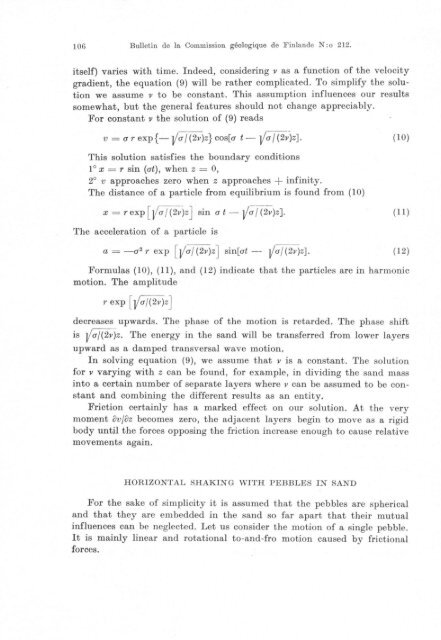COMMISSION GEOLOGIOUE - Arkisto.gsf.fi
COMMISSION GEOLOGIOUE - Arkisto.gsf.fi
COMMISSION GEOLOGIOUE - Arkisto.gsf.fi
Create successful ePaper yourself
Turn your PDF publications into a flip-book with our unique Google optimized e-Paper software.
106 Bulletin de la Commission geologique de Finlande N : 0 212.<br />
itself) varies with time. Indeed, eonsidering v as a funetion of the velo city<br />
gradient, the equation (9) will be rather complicated. To simplify the solution<br />
we assume v to be constant. This assumption influences our results<br />
somewhat, but the general features should not change appreciably.<br />
For constant v the solution of (9) reads<br />
v = ar exp{-Val(2v)z} cos[a t- Val (2v)z].<br />
( 10)<br />
This solution satis<strong>fi</strong>es the boundary eonditions<br />
1° x = r sin (at), when z = 0,<br />
2° v approaches zero when z approaches + in<strong>fi</strong>nity.<br />
The distance of a particle from equilibrium is found from (10)<br />
x = r exp [Va I (2v")zJ sin at -<br />
The aeceleration of a particle is<br />
Va I (2;)z].<br />
( 11)<br />
a = -a 2 r exp [Val (2v)zJ sin[at -<br />
Val (2v)z).<br />
( 12)<br />
Formulas (10), (11), and (12) indicate that the particles are in harmonie<br />
motion. The amplitude<br />
r exp [Val(2v)z ]<br />
decreases upwards. The phase of the motion is retarded. The phase shift<br />
is Val(2v)z. The energy in the sand will be transferred from lower layers<br />
upward as a damped transversal wave motion.<br />
In solving equation (9), we assume that v is a eonstant. The solution<br />
for v varying with z ean be found, for example, in dividing the sand mass<br />
into a eertain number of separate layers where v can be assumed to be eonstant<br />
and combining the different results as an entity.<br />
Friction eertainly has a marked effeet on our solution. At the very<br />
moment ovloz beeomes zero, the adjaeent layers begin to move as a rigid<br />
body until the forces opposing the friction inerease enough to eause relative<br />
movements again.<br />
HORIZONTAL SHAKING WITH PEBBLES IN SAND<br />
For the sake of simplieity it is assumed that the pebbles are spherical<br />
and that they are embedded in the sand so far apart that their mutual<br />
influenees ean be neglected. Let us consider the motion of a single pebble.<br />
It is mainly linear and rotational to-and-fro motion eaused by frictional<br />
forees.
















